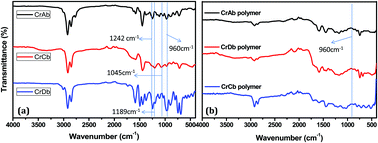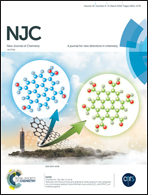Cardanol based benzoxazine blends and bio-silica reinforced composites: thermal and dielectric properties†
Abstract
In the present work, a novel cardanol based benzoxazine was synthesised by reacting three different amines (aniline (CrAb), N,N-dimethylaminopropylamine (CrDb) and caprolactam modified N,N-dimethylaminopropylamine (CrCb)) with cardanol in the presence of formaldehyde under appropriate experimental conditions. The resulting benzoxazines were characterised for their molecular structure and thermal behaviour using different analytical methods. Among the different systems studied, the tertiary amine derivatives were found to reduce the curing temperature efficiently (CrAb-275 °C > CrDb-265 °C > CrCb-251 °C) and were confirmed by DSC analysis. These cardanol based CrAb benzoxazines were blended with conventional benzoxazines (Bzs) and bismaleimides (BMIs) as binary and ternary systems and their thermal properties were studied. Three different catalysts (4-hydroxy acetophenone, 4-aminophenol, and 4-hydroxyphenyl maleimide) were used to study the effect of lowering the curing temperature. Further, the prepared benzoxazines were reinforced with varying weight percentages (1, 3, 5 and 10 wt%) of bio-silica derived from rice husk to obtain hybrid composites. The dielectric studies of bio-silica reinforced cardanol benzoxazines infer that the values of dielectric constant decreased with increasing wt% of bio-silica. It was further observed that 10 wt% bio-silica reinforced cardanol benzoxazines show the lowest value of dielectric constant of 1.9 at 1 MHz. From the data obtained from the different studies, it is concluded that the blends of cardanol based benzoxazines can be used in the form of sealants, encapsulants, adhesives and matrices in the fields of microelectronics and automobile applications for better performance.



 Please wait while we load your content...
Please wait while we load your content...